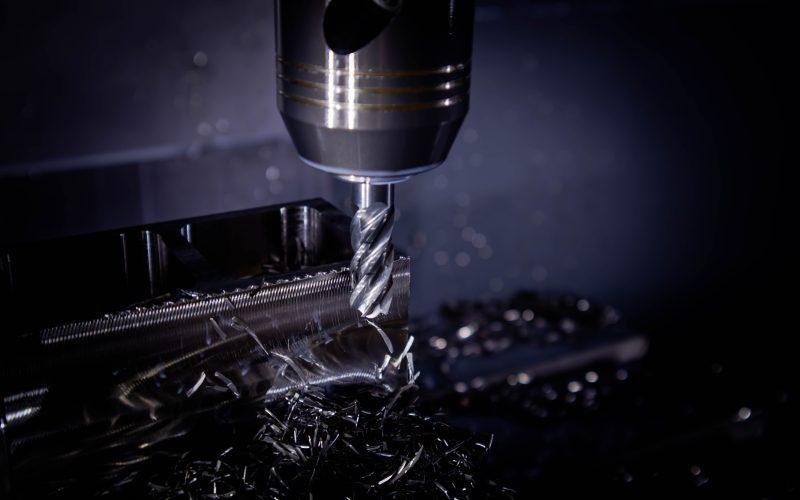
With growing Industry 4.0 advancements, manufacturing technologies like 3D printing and CNC machining are in high demand. 3D printing on one side is an innovative additive manufacturing method. On the other hand, CNC is a robust mass-manufacturing process.
If you wonder which one to pick between 3D printing vs CNC, then we’ve got you covered. Let’s jump into both of these manufacturing technologies so that you can choose the suitable one.
What is CNC Technology?
In CNC manufacturing, a rotating cutting tool is constantly moving parallel to a fixed surface. CNC or Computer Numerical Control is done under the guidance of computer-aided manufacturing (CAM). The computer displays real-time instructions that are followed by those machines.
Photo by Daniel Smyth on Unsplash
It is a subtractive manufacturing process in which engineers create an object by scraping off materials from a large work block. CNC machines are highly adaptable and can be used for hundreds of different applications like cutting, shaping, machining etc. The most significant advantage of CNC is its accuracy and speed. A high-quality machine cuts at a higher rate of 500 inches per minute (IPM).
How Does A CNC Machine Work?
CNC machines are generally divided into three sections:
- Spindle that holds a rotating milling or shaping tool.
- The work table where the material is placed and the final product will be formed. In most cases, it’s a flat metal plate with a grid structure to make sure that your piece stays in place.
- A computer-guided mechanism that consists of motors, controller, power supply etc.
The CNC machine reads the G-code that is generated by CAM software. The controller uses this information to run stepper motors to move the spindle and cutter head assembly concerning three-axis movements (X, Y, Z).
The spindle rotates at a different speed according to the material. It can be anything from 6,000 RPM for metal to 30,000 RPM for wood. In addition, the higher RPM also shortens the tool’s lifespan, which is why they are expensive.
What Is 3d Printing?
In 3D printing, a physical component is built by laying material in the required pattern. A 3d printer machine works with the help of a computer that has a 3D model loaded into it. The design file is then converted into an STL format and transposed into cross-sectional layers, after which they are then printed out one by one according to their respective speed.
Photo by Gavin Allanwood on Unsplash
It is also known as additive manufacturing in which successive layers of material are laid down. To be precise, 3D printing is based on the stereolithography method, in which a 3D printer uses a nozzle to spray out droplets of resin one by one until the desired shape is achieved. There are several 3D printing technologies available, including FDM, SLS, DMLS, and more.
How Does 3d Printing Work?
The 3D printer reads the STL file, which contains information about the model. It happens in two ways:
- The G-code is sent to a stepper motor that holds the print head to various axes per instructions mentioned in the code.
- The controller reads instructions from computer-aided design (CAD) software and sends the data to a 3D printer.
The printer heats the material then squeezes it in a syringe that extrudes an exact amount per layer. The 3D printer uses different printing materials, but the most common ones are thermoplastic polymers, resins, metals etc.
In 3d printing, the material wastage is minimum, so it reduces the manufacturing costs. Moreover, it is highly customizable, and the turnaround time of production is quick.
3D Printing vs CNC Machining: Similarities
- Both technologies are ideal for superior quality rapid prototyping and mass production.
- Both technologies support OBJ and STL files that are quick to create.
- 3D printing and CNC both require a 3D model to begin manufacturing.
3D Printing vs CNC Machining: Differences
- The material wastage is higher in CNC compared to 3d printing
- CNC can produce parts in various sizes. However, a 3D printer can only print a component as big as its printing bed.
- For bulk manufacturing, CNC is faster than 3d printing. On the other hand, additive manufacturing is more efficient in rapid prototyping than CNC.
CNC vs 3D Printing: Which One Is Ideal for Your Business?
The answer to this query is not direct because the comparison depends on your individual needs. However, you understand that different businesses demand different approaches, so you need to choose manufacturing technologies accordingly.
Before making a choice, you should consider many factors, such as the cost, time required to turn around your product, etc. If budget is not a hurdle and you need bulk products in less time, CNC machines are ideal for your business. On the other hand, if you don’t want to spend much and need good quality with quick production time, a 3d printing service can be a great choice.





